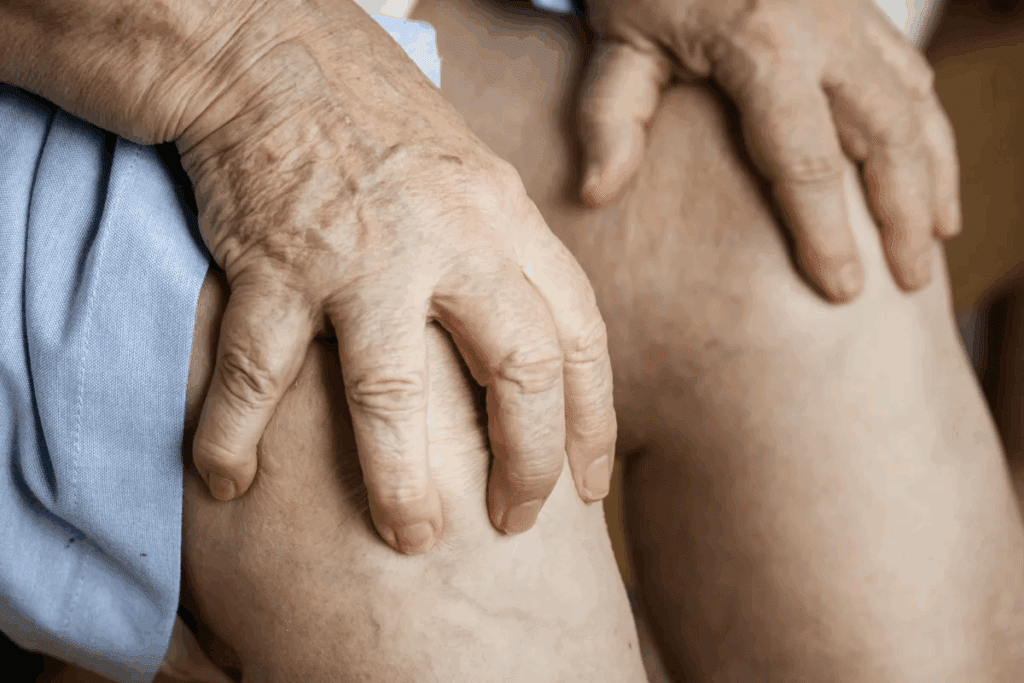Last Updated on November 27, 2025 by Bilal Hasdemir

Nearly 54 million adults in the United States have some form of arthritis. This condition causes joint pain and inflammation. Osteoarthritis vs rheumatoid arthritis is a common comparison, as both share similar symptoms, making it hard to tell them apart.
However, osteoarthritis vs rheumatoid arthritis are different diseases with unique causes and ways they affect the body. Understanding these differences is essential for getting the right diagnosis and treatment.
This article explores osteoarthritis vs rheumatoid arthritis, including their causes, symptoms, diagnosis, and treatment options. It aims to help you recognize which condition you may have and how to manage it effectively.
Key Takeaways
- Understanding the differences between osteoarthritis and rheumatoid arthritis is key for the right diagnosis.
- Both conditions cause joint pain, but their underlying causes differ.
- Comparing symptoms can help identify the type of arthritis.
- Diagnosis involves a combination of medical history, physical examination, and tests.
- Treatment options vary depending on the type and severity of the condition.
Understanding Arthritis and Its Impact
Arthritis is not just one disease; it refers to many inflammatory and degenerative joint disorders. Conditions like osteoarthritis and rheumatoid arthritis are part of it. Each has its own traits and effects on the body.
What is arthritis?
Arthritis brings joint pain, inflammation, and stiffness. It makes daily activities hard. Rheumatoid arthritis is an autoimmune disease. It happens when the immune system attacks the joints’ lining, causing inflammation and damage.
How arthritis affects daily life
Arthritis doesn’t just hurt joints; it affects overall health. Symptoms like morning stiffness and pain limit movement. They also change daily routines.
“Living with arthritis needs a full approach to manage symptoms and keep quality of life,” experts say. Arthritis’s impact on daily life is big. It affects not just the person but also their family and friends. Knowing about the condition is key to managing it well.
Osteoarthritis vs Rheumatoid Arthritis: A Comparative Look
The main difference between osteoarthritis and rheumatoid arthritis is their causes and symptoms. Both affect the joints but in different ways. Their effects on patients are also quite different.
Disease mechanisms and origins
Osteoarthritis happens when joints wear out over time. This leads to cartilage breakdown and joint pain. Rheumatoid arthritis, on the other hand, is an autoimmune disease. It makes the body’s immune system attack the joints, causing inflammation and damage.
Key distinguishing features
One big difference is inflammation. Rheumatoid arthritis has a lot of inflammation, swelling, and warmth in the joints. It also causes systemic symptoms like fatigue. Osteoarthritis mainly causes stiffness and pain in the joints.
Age and demographic differences
Osteoarthritis often starts in older adults, those with joint injuries, or obesity. Rheumatoid arthritis can happen at any age but peaks between 30 and 60. It’s more common in women.
Understanding these differences enables healthcare providers to make more accurate diagnoses and provide better treatment. By understanding osteoarthritis and rheumatoid arthritis, healthcare providers can give better care. This improves patients’ lives and manages symptoms effectively.
Osteoarthritis: The Degenerative Joint Disease
Osteoarthritis is the most common type of arthritis. It happens when cartilage in joints breaks down. This condition affects millions of people around the world.
Definition and Causes
Osteoarthritis is mainly caused by wear and tear on joints over time. This leads to cartilage damage. The cartilage acts as a cushion between bones.
Risk Factors for Developing Osteoarthritis
Several factors can increase your risk. These include older age, joint injury, and obesity. Age-related arthritis is another term for this condition as it often occurs with age.
Cartilage Breakdown Process
The breakdown of cartilage is a gradual process. It leads to localized pain and can cause arthritis joint deformities. When cartilage wears away, bones may rub against each other.
Knowing the causes and risk factors is key to managing the condition.
Rheumatoid Arthritis: The Autoimmune Condition
Rheumatoid arthritis (RA) is an autoimmune disease. It happens when the immune system attacks the lining of the joints. This leads to inflammation and damage.
Autoimmune Nature and Inflammation
RA is an autoimmune disease. This means the body’s immune system attacks its own tissues. This chronic inflammation causes pain, swelling, and can lead to joint deformity and loss of function.
Genetic and Environmental Triggers
The exact causes of RA are not fully known. But, genetic predisposition and environmental triggers are believed to play a big role. Smoking and certain infections may trigger RA in people who are genetically prone.
Systemic Effects Beyond Joints
RA affects more than just the joints. It can cause systemic effects like fatigue, fever, and extra-articular manifestations. These effects can impact overall health and quality of life.
| Aspect | Description |
| Autoimmune Nature | Immune system attacks joint linings |
| Inflammation | Causes pain, swelling, and joint damage |
| Systemic Effects | Fatigue, fever, and extra-articular manifestations |
Pain Characteristics: How Each Type Feels Different
The pain in osteoarthritis and rheumatoid arthritis shows their differences. Knowing these pain types helps us tell them apart.
Osteoarthritis pain: gradual and activity-related
Osteoarthritis pain starts slowly and gets worse with activity. It eases when you rest. For example, knee pain from osteoarthritis gets better when you stop moving.
Rheumatoid arthritis pain: persistent and inflammatory
Rheumatoid arthritis pain lasts longer and is more inflammatory. It can happen even when you’re not moving. You might also feel swelling and warmth in your joints.
Morning stiffness duration differences
Morning stiffness is a big difference between the two. Osteoarthritis causes short stiffness, under 30 minutes. But rheumatoid arthritis causes stiffness that lasts over an hour.
| Pain Characteristic | Osteoarthritis | Rheumatoid Arthritis |
| Onset | Gradual | Sudden or gradual |
| Relation to Activity | Worsens with activity | Can occur at rest |
| Morning Stiffness Duration | Less than 30 minutes | More than an hour |
Looking at pain and symptoms helps doctors tell osteoarthritis from rheumatoid arthritis. This leads to better diagnoses and treatments.
Joint Involvement Patterns
Understanding these differences enables healthcare providers to make more accurate diagnoses and provide better treatment.
Weight-bearing and Frequently Used Joints in Osteoarthritis
Osteoarthritis mainly hits joints that bear weight, like hips, knees, and spine. It also affects joints that get used a lot, like hands. This condition causes localized pain in these joints. The pain gets worse with activity and better with rest.
Symmetrical Small Joint Involvement in Rheumatoid Arthritis
Rheumatoid arthritis, by contrast, often causes symmetrical pain in small joints, like hands and feet. This symmetry is a key sign that sets it apart from osteoarthritis.
“The symmetrical involvement of small joints is a characteristic feature of rheumatoid arthritis, setting it apart from osteoarthritis.”
Unique Joint Presentations in Each Condition
Each arthritis type has its own way of affecting joints. Osteoarthritis can cause joints to deform because of cartilage loss. Rheumatoid arthritis leads to inflammation and deformities because it’s an autoimmune disease. Knowing these differences is vital for managing and treating each condition.
Both conditions can lead to “arthritis joint deformities.” But the reasons and how joints are involved are very different.
Swelling, Warmth, and Visible Signs
Swelling, warmth, and other signs can help tell osteoarthritis from rheumatoid arthritis. Knowing these differences is key for a correct diagnosis.
Mild vs. Pronounced Inflammation
Rheumatoid arthritis has pronounced inflammation. This causes a lot of swelling and warmth in the joints. On the other hand, osteoarthritis has mild inflammation. It leads to less swelling.
Joint Appearance Differences
The look of joints changes a lot between the two diseases. Rheumatoid arthritis causes symmetrical swelling. Osteoarthritis affects joints in an uneven way.
Skin Changes and Nodules
Skin changes and nodules are more common in rheumatoid arthritis. These nodules are firm lumps under the skin. They can help tell the two apart.
| Characteristic | Osteoarthritis | Rheumatoid Arthritis |
| Inflammation Level | Mild | Pronounced |
| Swelling | Less noticeable | Significant |
| Skin Changes | Rare | Common, with nodules |
It’s important to know these signs and their differences. This helps in diagnosing and managing arthritis well.
Systemic Symptoms and Overall Health Impact
Rheumatoid arthritis affects more than just the joints. It’s a systemic autoimmune condition that impacts overall health. Unlike osteoarthritis, which mainly affects joints, rheumatoid arthritis can affect many parts of the body.
Fatigue and Malaise in Rheumatoid Arthritis
Fatigue is a common symptom of rheumatoid arthritis. It can make everyday tasks hard. People often feel a general feeling of malaise too.
Fever and Weight Changes
Rheumatoid arthritis can also cause fever and changes in weight. Some people might have a low-grade fever. Others might see big changes in their weight due to inflammation and metabolic changes.
Extra-Articular Manifestations
Rheumatoid arthritis can also affect organs like the eyes, lungs, and heart. This can lead to conditions like rheumatoid nodules, lung disease, and heart disease. It shows why treating the condition fully is important.
It’s key to understand these systemic symptoms to manage rheumatoid arthritis well. Healthcare providers can create better treatment plans by seeing the condition’s wide impact. This way, they can address both joint and systemic symptoms.
Self-Assessment: Questions to Ask Yourself
To understand your arthritis better, think about a few important things. This self-check will help you grasp your situation. It also prepares you for talking to a doctor.
Age of Symptom Onset
The age when your symptoms started can tell you a lot. Osteoarthritis usually shows up after 40. But rheumatoid arthritis can start at any age, even in kids and young adults.
Pattern and Timing of Joint Pain
It’s key to know when and how your joint pain happens. Ask yourself if the pain is always there or if it changes. Also, think about if it gets worse with activity or when you’re resting.
Family History Considerations
Arthritis in your family can hint at your own condition. Both types have a genetic link. Knowing your family’s health history can offer clues.
Symptom Triggers and Relievers
Figuring out what makes your symptoms worse and what helps can be useful. Things like exercise, weather, or food might trigger your pain. But rest, medicine, or certain exercises might make you feel better.
- Keep a symptom diary to track when your symptoms occur and what might have triggered them.
- Note any factors that seem to relieve your symptoms.
- Share this information with your healthcare provider to aid in diagnosis.
Diagnostic Methods: How Doctors Tell the Difference
To figure out if a patient has osteoarthritis or rheumatoid arthritis, doctors use several methods. These steps are key to making an accurate diagnosis. This diagnosis then helps decide the best treatment.
Physical Examination Findings
A detailed physical check-up is the first step in diagnosing arthritis. Doctors look at joint mobility, swelling, and tenderness. In osteoarthritis, joints might be stiff and move less. In rheumatoid arthritis, joints are warm, swollen, and sore.
X-rays and Imaging Differences
Imaging tests, like X-rays, help tell the two conditions apart. Osteoarthritis shows joint space narrowing and bone spurs. Rheumatoid arthritis has
Blood Tests for Rheumatoid Factor and Antibodies
Blood tests are key in diagnosing rheumatoid arthritis. Finding rheumatoid factor and anti-CCP antibodies often means it’s rheumatoid arthritis. These tests help rule out osteoarthritis, which doesn’t show these markers.
Joint Fluid Analysis
Joint fluid analysis looks at the fluid in the joint. In osteoarthritis, the fluid is clear with few white blood cells. But in rheumatoid arthritis, the fluid is inflammatory with more white blood cells.
By using these methods together, doctors can accurately diagnose and tell osteoarthritis from rheumatoid arthritis. This makes it easier to choose the right treatment.
Disease Progression and Long-term Outlook
Osteoarthritis and rheumatoid arthritis progress differently, affecting patients in unique ways. Knowing these differences is key to better management and improving life quality.
Slow, Predictable Progression
Osteoarthritis moves slowly and in a predictable way. It gets worse over time, but at different rates for everyone. Age, weight, and injuries can speed up this process. As it worsens, joints can suffer significant damage and lose function.
Flares and Remissions
Rheumatoid arthritis, by contrast, has ups and downs. Flares make symptoms worse and inflammation higher. Remissions bring relief and lower inflammation. This unpredictable pattern means constant adjustments in treatment are needed.
Joint Deformities and Functional Limitations
Both diseases can cause joint deformities and limit function. Osteoarthritis wears down joints, often in weight-bearing ones. Rheumatoid arthritis damages joints symmetrically, leading to disability if not managed well. These limitations affect daily life and overall well-being.
Complications Beyond the Joints
Both diseases can affect more than just joints. Rheumatoid arthritis can harm the heart and lungs, being an autoimmune disease. Osteoarthritis, mainly a joint issue, also impacts health through reduced mobility and pain. Treating these conditions requires a holistic approach, focusing on both joint health and overall well-being.
Conclusion: Getting the Right Diagnosis and Treatment
Getting a correct diagnosis is key to managing arthritis well. It’s important to know the difference between osteoarthritis and rheumatoid arthritis. This helps in choosing the right treatment.
Osteoarthritis and rheumatoid arthritis need different treatments. For osteoarthritis, the focus is on pain management and improving joint function. Rheumatoid arthritis treatment often includes DMARDs to slow the disease.
Seeing a doctor is the first step to find the best treatment. Doctors can guide patients through arthritis treatment options. This includes medicines, lifestyle changes, and other therapies.
With the right diagnosis and a doctor’s help, people can create a treatment plan. This plan helps manage symptoms and improve life quality.
FAQ
What are the main differences between osteoarthritis and rheumatoid arthritis?
Osteoarthritis is a disease where cartilage breaks down. Rheumatoid arthritis is an autoimmune disease that causes inflammation and damage. They have different causes, symptoms, and treatments.
How can I determine if my joint pain is caused by osteoarthritis or rheumatoid arthritis?
Look at your age, symptoms, and family history. Osteoarthritis usually affects older people and causes pain with activity. Rheumatoid arthritis can happen at any age and causes persistent pain and stiffness in the morning.
What are the risk factors for developing osteoarthritis?
Factors include age, being overweight, joint injuries, and repetitive strain. Genetics also play a part.
How does rheumatoid arthritis affect overall health beyond the joints?
It can cause fatigue, fever, and weight changes. It can also lead to skin changes and nodules.
What diagnostic methods are used to differentiate between osteoarthritis and rheumatoid arthritis?
Doctors use physical exams, X-rays, and blood tests. These help diagnose and differentiate between the two conditions.
Can osteoarthritis and rheumatoid arthritis be treated with the same medications?
Some medications are used for both. But, treatment for osteoarthritis focuses on pain and joint function. Rheumatoid arthritis treatment aims to reduce inflammation and prevent damage.
How do the pain characteristics of osteoarthritis and rheumatoid arthritis differ?
Osteoarthritis pain is gradual and related to activity. Rheumatoid arthritis pain is constant and inflammatory. Morning stiffness is longer with rheumatoid arthritis.
Are there any lifestyle changes that can help manage osteoarthritis and rheumatoid arthritis symptoms?
Yes, staying healthy, exercising, and managing stress can help with both conditions.
Can age-related arthritis be prevented or slowed down?
Age-related arthritis can’t be completely prevented. But, a healthy lifestyle can slow its progression.
How do osteoarthritis and rheumatoid arthritis affect joint deformities and functional limitations?
Both can cause joint deformities and limitations. But, rheumatoid arthritis can lead to severe damage and disability if not treated well.
References
- Zhang, Z., et al. (2024). Similarities and differences between osteoarthritis and rheumatoid arthritis. Journal of Translational Medicine, 22, Article 5643 https://translational-medicine.biomedcentral.com/articles/10.1186/s12967-024-05643-4






